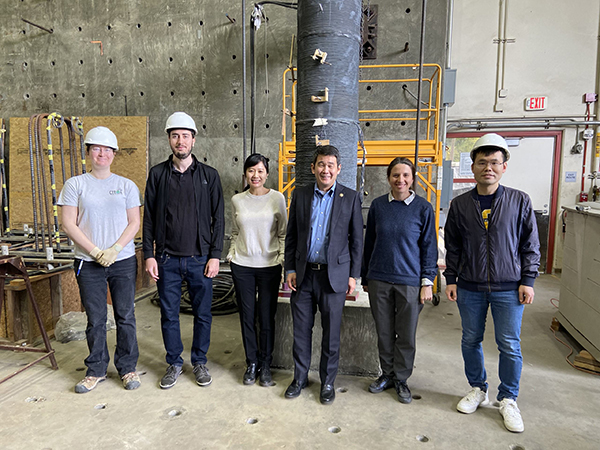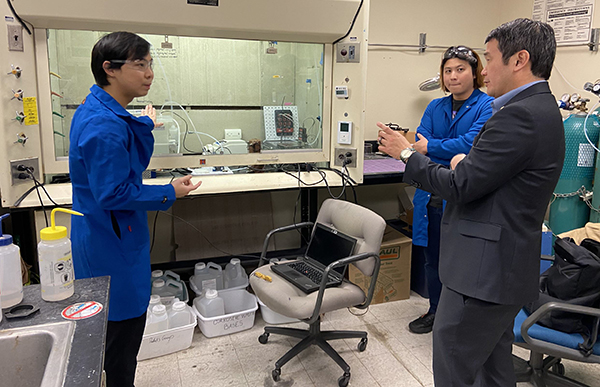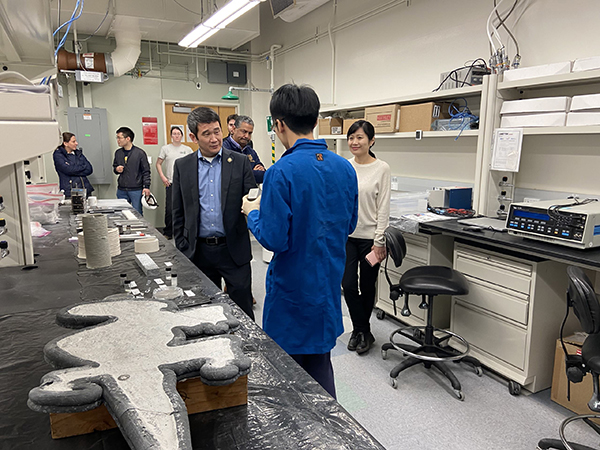U.S. Rep. Dave Min Visits UCI Engineering to Learn About Cement Decarbonization Innovations

Feb. 10, 2025 – U.S. Rep. Dave Min visited the UC Irvine School of Engineering Thursday morning, Jan. 30 to learn about two engineering professors’ groundbreaking efforts to electrify the carbon-heavy cement manufacturing process – one of the world’s largest sources of industrial pollution. UCI professors Mo Li and Iryna Zenyuk recently won $3 million in research funding from the U.S. Department of Energy to advance their work in this critical area.
Li, a professor of civil and environmental engineering and PI of the project, joined forces with Zenyuk, a professor of chemical and biomolecular engineering and a co-PI, to tackle one of the most challenging sectors to decarbonize: cement manufacturing. Cement is the key ingredient in concrete, the most widely used man-made material on earth, with over four billion metric tons produced per year. As the second-largest cement-producing state in the U.S. after Texas, California plays a pivotal role in advancing sustainable solutions for this industry.
The current cement manufacturing process generates massive carbon emissions, primarily from the combustion of fossil fuels to generate the high temperature required in conventional kilns, as well as from the decomposition of limestone during the process.
The UCI researchers have developed a cleaner way. They seek to enable net-zero-carbon cement manufacturing by replacing the high-temperature combustion process with an electrochemical process. This innovative clean manufacturing method eliminates CO2 emissions from fossil fuel combustion, efficiently captures and re-uses CO2 released during the conversion of CaCO3 to Ca(OH)2, transforming it into value-added products, and incorporates waste streams into novel lower-temperature cement synthesis processes. This process also minimizes pyro-processing CO2 emissions.
“Our electrolyzer will be powered by solar and wind energy,” said Zenyuk. “With this technology, we will reduce CO2 emissions and we’ll produce cleaner cement.”

“It’s incredible to see all the brain power focused on solving such a critical problem,” said Min, after attending a presentation by the professors and touring UCI’s cement and electrochemistry labs. He also spoke with the graduate students and postdoctoral researchers contributing to the project.
Their research is designed to be scalable to existing cement plants. “We have a proof of concept and have studied the fundamentals. With this new DOE funding, we will demonstrate how our electrochemical process can decarbonize cement and concrete manufacturing by producing several different material systems, including one similar to commercially available Portland cement,” said Li. “We will also validate cement production standards, assess mechanical and durability properties, and conduct life cycle and techno-economic analyses. Ultimately, we will identify the path forward for large-scale demonstration and deployment of this technology.”
“It’s impressive to see such interdisciplinary expertise brought to bear on this important issue,” said Min. “It’s also a good example of how federal government funding can be used to solve problems by supporting the brilliant minds who are at work on how to decarbonize cement.”

In Li and Zenyuk labs, researchers showcased to Rep. Min the UCI-patented electrolyzer cell designs and processes for cement manufacturing, a range of cement-based materials with proven properties and functionalities, and scaled-up concrete structural components, including robotically additive manufactured concrete columns being tested under wind and seismic loads.
The $3 million project is funded by the U.S. Department of Energy’s Office of Energy Efficiency and Renewable Energy as part of a its efforts to drive industrial energy use and emissions down. The UCI researchers are partnering with Cemento Argos, Oak Ridge National Laboratory, and electrochemical tech company De Nora.
The PIs are thrilled that U.S. DOE selected their team to receive this funding to accelerate the development of innovative technologies to ensure the competitiveness of U.S. industrial supply chains in global markets.
America’s industrial sector is critical to the nation’s economy. This project supports the research and development of transformational technologies essential for reducing energy demand, creating jobs, improving American productivity in key industrial subsectors, and creating healthy communities across America.
– Lori Brandt

